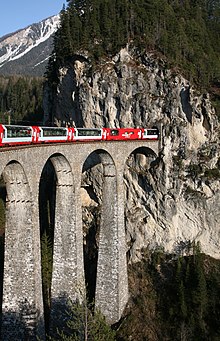46°35′42″N 9°45′36″E / 46.59500°N 9.76000°E
| Glacier Express | |
|---|---|
 The Glacier Express traversing the Landwasser Viaduct just before arriving in Filisur. | |
| Overview | |
| Service type | Tourist train |
| Status | Operating daily except for maintenance period in late autumn |
| Locale | Graubünden, Uri and Valais, Switzerland |
| Predecessor | |
| First service | 25 June 1930 07:30 |
| Current operator(s) | Glacier Express AG, Andermatt |
| Ridership | 187,000 (2016) |
| Route | |
| Termini | Brig, Zermatt St. Moritz / Davos (change in Filisur), Chur |
| Stops | Fiesch, Andermatt, Disentis/Mustér, Chur, Thusis, Tiefencastel, Filisur, Bergün/Bravuogn, Samedan, Celerina |
| Distance travelled | 291 kilometres (181 mi) |
| Average journey time |
|
| Service frequency | December–April (both directions):[1]
|
| On-board services | |
| Class(es) | 1st and 2nd |
| Disabled access | Yes |
| Catering facilities | Restaurant car |
| Observation facilities | Panorama cars |
| Technical | |
| Rolling stock | Panorama cars Restaurant car |
| Track gauge | 1,000 mm (3 ft 3+3⁄8 in) metre gauge |
| Electrification | 11 kV AC 162⁄3 Hz |
| Track owner(s) | RhB, MGB |
The Glacier Express is a direct train connecting railway stations of the two major mountain resorts of Zermatt and St. Moritz via Andermatt in the central Swiss Alps. The train provides a one-seat ride for an 8-hour end-to-end 291-kilometre (181 mi) journey, and omits stops made by local trains. The Glacier Express has been called the 'slowest express train in the world'.[2] As St. Moritz and Zermatt are home to two well-known mountains, the Glacier Express is also said to travel from Matterhorn to Piz Bernina.[citation needed]
The journey from Zermatt starts at the dead end of an Alpine valley, the Mattertal, just below the world-renowned Matterhorn at an elevation of 1,606 m (5,269 ft) before it descends to the huge valley of the Valais in Brig. It journeys 291 kilometres (181 mi) through the center of the Swiss Alps, over 291 bridges, through 91 tunnels — such as the 15.4 km-long (9.6 mi) Furka Tunnel at an elevation of 1,500 m (4,900 ft), which circumvents the Furka Pass — makes an intermediate stop at Andermatt in a secluded high Alpine valley, and traverses its high point on the Oberalp Pass at 2,033 m (6,670 ft) before descending to its low point at Chur at 585 m (1,919 ft). From Chur, the capital of the canton of Graubünden, the Glacier Express regains altitude, stopping at Filisur — where travelers can change for a connecting train to reach Davos to the east — and then traverses the Albula Range via a tunnel at 1,800 metres (5,900 ft) to reach the resort St. Moritz in a valley to the south.
Since 2017, the train has been operated by the Glacier Express AG, a cooperation jointly owned by the former operators Matterhorn Gotthard Bahn (MGB) and Rhaetian Railway (RhB). For much of its journey, it also passes along and through the World Heritage Site known as the "Rhaetian Railway in the Albula / Bernina Landscapes".
The first Glacier Express started on 30 June 1930 at 07:30 in Zermatt. Initially, it was operated by three railway companies: the Visp-Zermatt-Bahn (VZ), the Furka Oberalp Bahn (FO), and the Rhätische Bahn (RhB). From 2003 to 2017, the train was operated by Rhätische Bahn (RhB) and the Matterhorn Gotthard Bahn (MGB), which arose from a merger between the BVZ and the FO.
The entire line is metre gauge (narrow gauge), with 23.9 kilometres (14.9 mi) using the rack-and-pinion system both for ascending steep grades and to control descent.